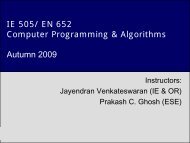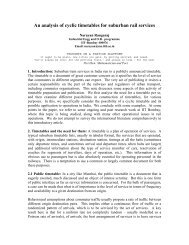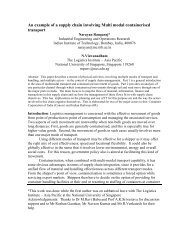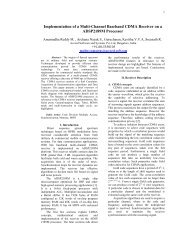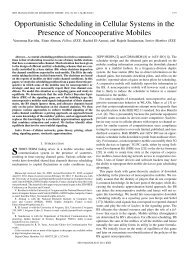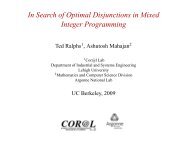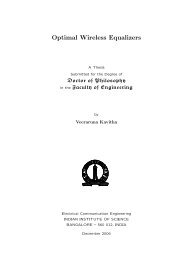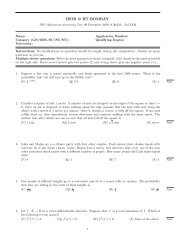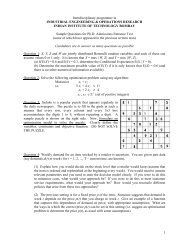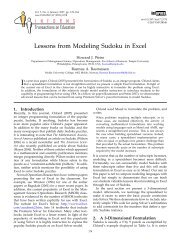A Monte Carlo Approach to Currency Risk Minimization - IEOR @IIT ...
A Monte Carlo Approach to Currency Risk Minimization - IEOR @IIT ...
A Monte Carlo Approach to Currency Risk Minimization - IEOR @IIT ...
You also want an ePaper? Increase the reach of your titles
YUMPU automatically turns print PDFs into web optimized ePapers that Google loves.
2003) and the specific case of exchange rate risk comes under currency risk management(Stephens, 2001; Xin, 2003).<strong>Risk</strong> management consists primarily of an accurate analysis of the risk fac<strong>to</strong>rsinvolved(FX rate, in this case) and take appropriate action <strong>to</strong> mitigate the risk. Any such actionis known as hedging. There are many alternatives available <strong>to</strong> the company for hedgingincluding conversion of FC <strong>to</strong> HC at an appropriate time or enter in<strong>to</strong> different hedgingcontracts with some financial institution. Such contracts may involve FX instruments(also known as hedges) such as forwards, futures, swaps, and a variety of FX options(Stephens, 2001; Xin, 2003). Specifically, a FX forward is an agreement between thetwo parties <strong>to</strong> exchange currencies, namely, <strong>to</strong> buy or sell a particular currency at apredetermined future date and a predetermined exchange rate. It costs nothing <strong>to</strong> entera forward contract. The party agreeing <strong>to</strong> buy the currency in the future assumes along position, and the party agreeing <strong>to</strong> sell the currency in the future assumes a shortposition. The price agreed upon is called the delivery price, which is equal <strong>to</strong> the forwardrate at the time of initiation of the contract. An option sets a rate at which the companymay choose <strong>to</strong> exchange currencies. If the exchange rate at option maturity is morefavorable, then the company will not exercise this option. Forward FX contracts areconsidered <strong>to</strong> be the simplest and the most widely used instrument for currency hedging.Their popularity may be partially explained by their simplicity, their initial zero cost, andfeasibility of over-the-counter (OTC) trading that permits exact specifications regardingdates and amounts. In this paper, we primary focus on optimal hedging problem usingForward FX contracts as a hedging instrument although the overall methodology caneasily be extended <strong>to</strong> include other instruments. For a general introduction <strong>to</strong> various(equity-based) financial instruments and their utility in heading, see Wilmott (2007); Hull(2008).Ahedging strategy represents atradingstrategyinvolving differenttypesofhedgesthatcan reduce currency risk. The hedging strategy typically depends on information such asexchange rate fluctuations and possibly a predictive model for the exchange rate (the socalled market view). These hedging schemes involve forward-rate based transactions <strong>to</strong>essentially lock infutureexchange rate. Suppose a company isexpecting a certain amoun<strong>to</strong>fFCatafuturedate. Thecompanyhasachoiceofdoingnothing(no hedging),enter in<strong>to</strong>a hedging contract once (static hedging), or enter in<strong>to</strong> multiple contracts at different times(dynamic hedging). The choice depends on various reasons including the companies viewon the market and service costs <strong>to</strong> enter hedging contracts. If the company can eliminateorachieve minimumpossibleriskusingnohedgingorstatichedgingthendynamichedgingoffers no advantage. However, in highly volatile periods, dynamic hedging may achievesignificantly less risk compared <strong>to</strong> static hedging. <strong>Currency</strong> risk hedging remains anactiveareaofresearch(Stephens, 2001;Xin,2003;Gagnonetal.,1998;LypnyandPowalla, 1998;Campbell etal.,2010;GlenandJorion,1993;Chang,2011). Mos<strong>to</strong>ftheexisting literatureeither focuses on static hedging or specific risk measures such as variance. In this paper,we present a general framework for designing risk optimal discrete-time dynamic hedgingstrategy where the risk measure can be chosen arbitrarily.Below, we summarize our framework for obtaining the optimal hedging strategy:i) In this paper, we assume that the FX rate follows a geometric Brownian motion2



